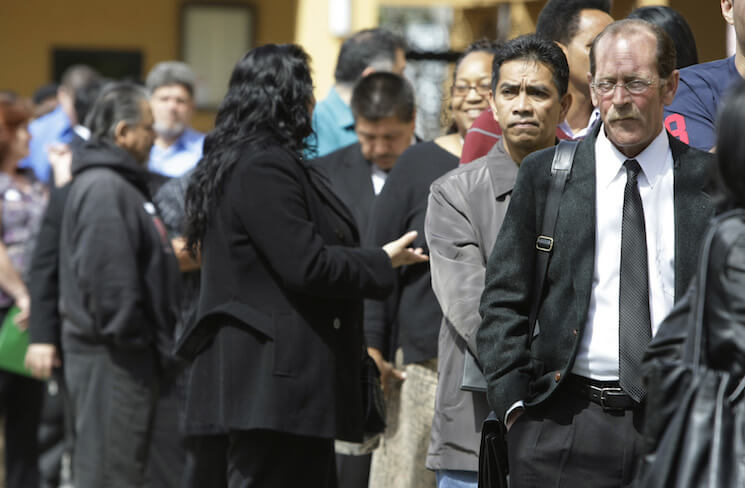Brad DeLong: Worthy reads on equitable growth, September 23–27, 2019
Worthy reads from Equitable Growth:
- I wish to once again flag this: Recession Ready. We are not yet out of time to take steps to keep the next U.S. recession from turning into a depression. But the clock is ticking. Here is an issue are in which the sooner we take action, the better. And in this book, we at Equitable Growth and the Hamilton Project have, I think, done a very good job: Read Recession Ready, which begins: “Economic recessions are inevitable and they are painful, with harsh short-term effects on families and businesses and potentially deep long-term impacts on the economy and society. But we can ameliorate some of the next recession’s worst effects and minimize its long-term costs if we adopt smart policies now that will be triggered when its first warning signs appear. Equitable Growth has joined forces with the Hamilton Project to advance a set of specific, evidence-based policy ideas for shortening and easing the impacts of the next recession.”
- Read this very nice piece by our young whippersnapper Raksha Kopparam summarizing the strong evidence that societal well-being is badly damaged by yet another pharmaceutical industry market failure. Read her “Killer acquisitions lead to decreased innovation and competition in the U.S. prescription drug market,” in which she writes: “Consolidation in the pharmaceutical industry is probably stifling rather than promoting innovation. Approximately 6 percent of pharmaceutical acquisitions are what the authors refer to as ‘killer acquisitions,’ in which an incumbent firm acquires a product in development that could compete with the incumbent’s own product and then subsequently terminates development of the target firm’s product, thus killing competition and innovation.”
- Five years ago, our Steering Committee member Janet Yellen gave a very good talk on building blocks of opportunity in America. Read Janet Yellen, “Perspectives on Inequality and Opportunity from the Survey of Consumer Finances,” in which she said: “[I] identify and discuss four sources of economic opportunity in America—think of them as “building blocks” for the gains in income and wealth that most Americans hope are within reach of those who strive for them. The first two are widely recognized as important sources of opportunity: resources available for children and affordable higher education. The second two may come as more of a surprise: business ownership and inheritances. Like most sources of wealth, family ownership of businesses and inheritances are concentrated among households at the top of the distribution. But both of these are less concentrated and more broadly distributed than other forms of wealth, and there is some basis for thinking that they may also play a role in providing economic opportunities to a considerable number of families below the top.”
- Equitable Growth Research Advisory Board member Arindrajit Dube at the University of Massachusetts Amherst writes about his long-time mentor and friend Marty Weitzman, who died by suicide last month.
Worthy reads not from Equitable Growth:
- One of the most intriguing anomalies in all of behavioral economics is the so-called Monty Hall problem—many people refusing to believe that revealing apparently irrelevant information can and should change your assessment of likelihoods and thus your optimal decision. Perhaps this is because we are wired at a fairly deep level to believe in “no correlation without causation.” We have to see a causal link between two phenomena in order to be willing to believe that they are correlated. Whether that is the explanation or not, it is clear that those of us who are bears of little brain need a lot of systematic help in parsing out issues of causation in complicated systems. And here, Dana Mackenzie and Judea Pearl’s The Book of Why: The New Science of Cause and Effect is going to be of enormous help in providing a gentle introduction to the issues and framework for thought. Read a review of the book by the extremely sharp Lisa Goldberg, in which she writes: “Pearl’s co-author Dana Mackenzie spoke on causal inference … It concluded with an image of the first self-driving car to kill a pedestrian … With a lead time of a second and a half, the car identified the object as a pedestrian. When the car attempted to engage its emergency braking system, nothing happened. The NTSB report states that engineers had disabled the system in response to a preponderance of false positives in test runs. The engineers were right, of course, that frequent, abrupt stops render a self-driving car useless. Mackenzie gently and optimistically suggested that endowing the car with a causal model that can make nuanced judgments about pedestrian intent might help … Professor Judea Pearl has given us an elegant, powerful, controversial theory of causality. How can he give his theory the best shot at changing the way we interpret data? There is no recipe for doing this, but teaming up with science writer and teacher Dana Mackenzie, a scholar in his own right, was a pretty good idea.”
- Are the unmeasured societal well-being benefits of new technologies 0.02 percent a year, or 0.1 percent, 0.5 percent, or perhaps 2.5 percent or more? I tend to be on the side something between 0.5 percent and 2.5 percent—the fact that people with a poverty-line income of $25,000 for a family of four seem, to me, to live better than people with the same nominal income in any past generation is, for me, dispositive. Public and private health, entertainment, and information technologies are “seismic,” and seem, to me, to have overwhelmed the rest. But here we have smart people disagreeing. Plus—an issue that they do not raise—is Facebook actually a net plus? You can make the case that it has not been. Read Erik Brynjolfsson, Avinash Collis, W. Erwin Diewert, Felix Eggers, and Kevin J. Fox, “GDP-B: Accounting for the Value of New and Free Goods in the Digital Economy,” in which they write: “The welfare contributions of the digital economy, characterized by the proliferation of new and free goods, are not well-measured in our current national accounts. We derive explicit terms for the welfare contributions of these goods and introduce a new metric, GDP-B, which quantifies their benefits, rather than costs. We apply this framework to several empirical examples, including Facebook and smartphone cameras, and estimate their valuations through incentive compatible choice experiments. For example, including the welfare gains from Facebook would have added between 0.05 and 0.11 percentage points to GDP-B growth per year in the United States.”
- The extremely smart Ricardo Hausmann has good ideas for the reform of public policy school education. Read his “Don’t Blame Economics, Blame Public Policy,” in which he writes: “Public policy schools, which typically have a strong economics focus, must now rethink the way they teach students—and medical schools could offer a model to follow … Economics is to public policy what physics is to engineering, or biology to medicine. While physics is fundamental to the design of rockets that can use energy to defy gravity, Isaac Newton was not responsible for the Challenger space shuttle disaster. Nor was biochemistry to blame for Michael Jackson’s death. Physics, biology, and economics, as sciences, answer questions about the nature of the world … generating … propositional knowledge. Engineering, medicine, and public policy, on the other hand, answer questions about how to change the world … Although engineering schools teach physics and medical schools teach biology, these professional disciplines have grown separate from their underlying sciences … Public policy schools, by contrast, have not undergone an equivalent transformation … Policy experience before achieving professorial tenure is discouraged and rare. And even tenured faculty have surprisingly limited engagement with the world, owing to prevailing hiring practices and a fear that engaging externally might entail reputational risks for the university. To compensate for this, public policy schools hire professors of practice, such as me, who have acquired prior policy experience elsewhere … The teaching-hospital model could be effective in public policy … Consider, for example, Harvard University’s Growth Lab, which I founded in 2006 after two highly fulfilling policy engagements in El Salvador and South Africa.”
- This is absolutely brilliant, and quite surprising to me. I had imagined that most of discrimination in the aggregate was the result of a thumb placed lightly on the scale over and over and over again. Patrick Kline and Christopher Walters present evidence that, at least in employment, it is very different—that a relatively small proportion of employers really, really discriminate massively, and that most follow race-neutral procedures and strategies. Read Patrick Kline and Christopher Walters, “Audits as Evidence: Experiments, Ensembles, and Enforcement,” in which they write: “We develop tools for utilizing correspondence experiments to detect illegal discrimination by individual employers. Employers violate U.S. employment law if their propensity to contact applicants depends on protected characteristics such as race or sex. We establish identification of higher moments of the causal effects of protected characteristics on callback rates as a function of the number of fictitious applications sent to each job ad. These moments are used to bound the fraction of jobs that illegally discriminate. Applying our results to three experimental datasets, we find evidence of significant employer heterogeneity in discriminatory behavior, with the standard deviation of gaps in job-specific callback probabilities across protected groups averaging roughly twice the mean gap. In a recent experiment manipulating racially distinctive names, we estimate that at least 85 percent of jobs that contact both of two white applications and neither of two black applications are engaged in illegal discrimination. To assess more carefully the tradeoff between type I and II errors presented by these behavioral patterns, we consider the performance of a series of decision rules for investigating suspicious callback behavior under a simple two-type model that rationalizes the experimental data. Though, in our preferred specification, only 17 percent of employers are estimated to discriminate on the basis of race, we find that an experiment sending 10 applications to each job would enable accurate detection of 7 percent to 10 percent of discriminators while falsely accusing fewer than 0.2 percent of nondiscriminators.”






